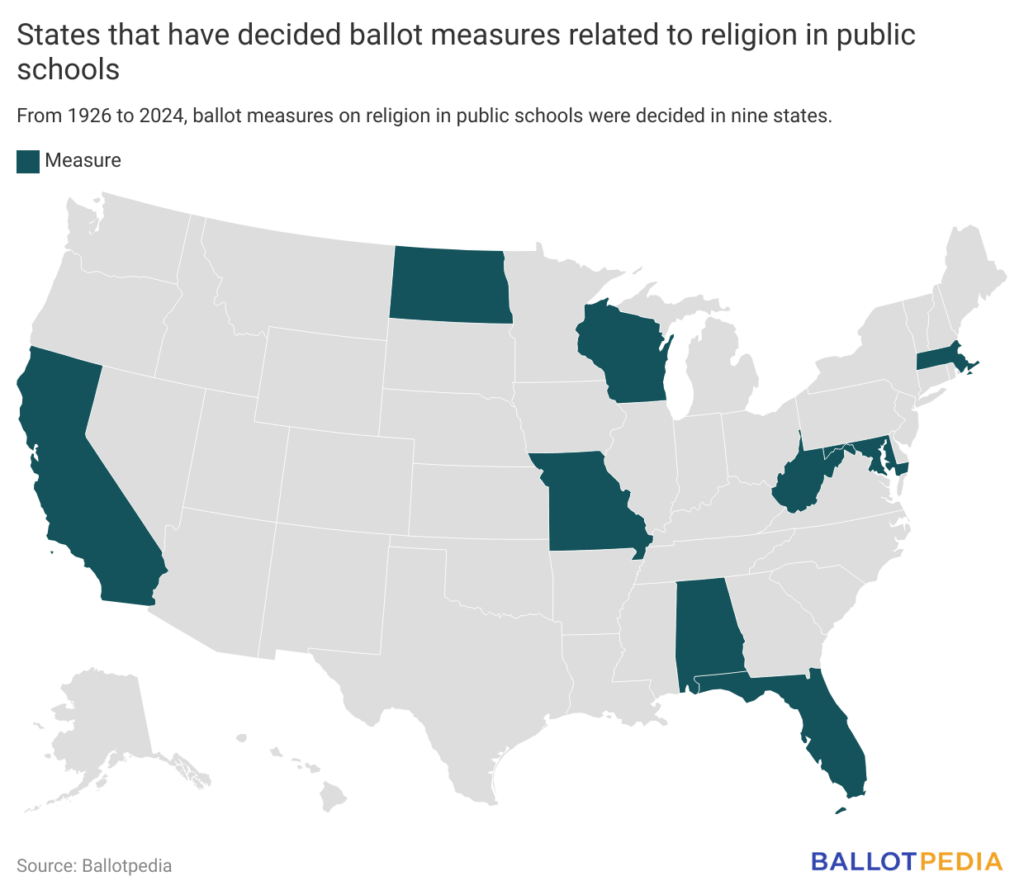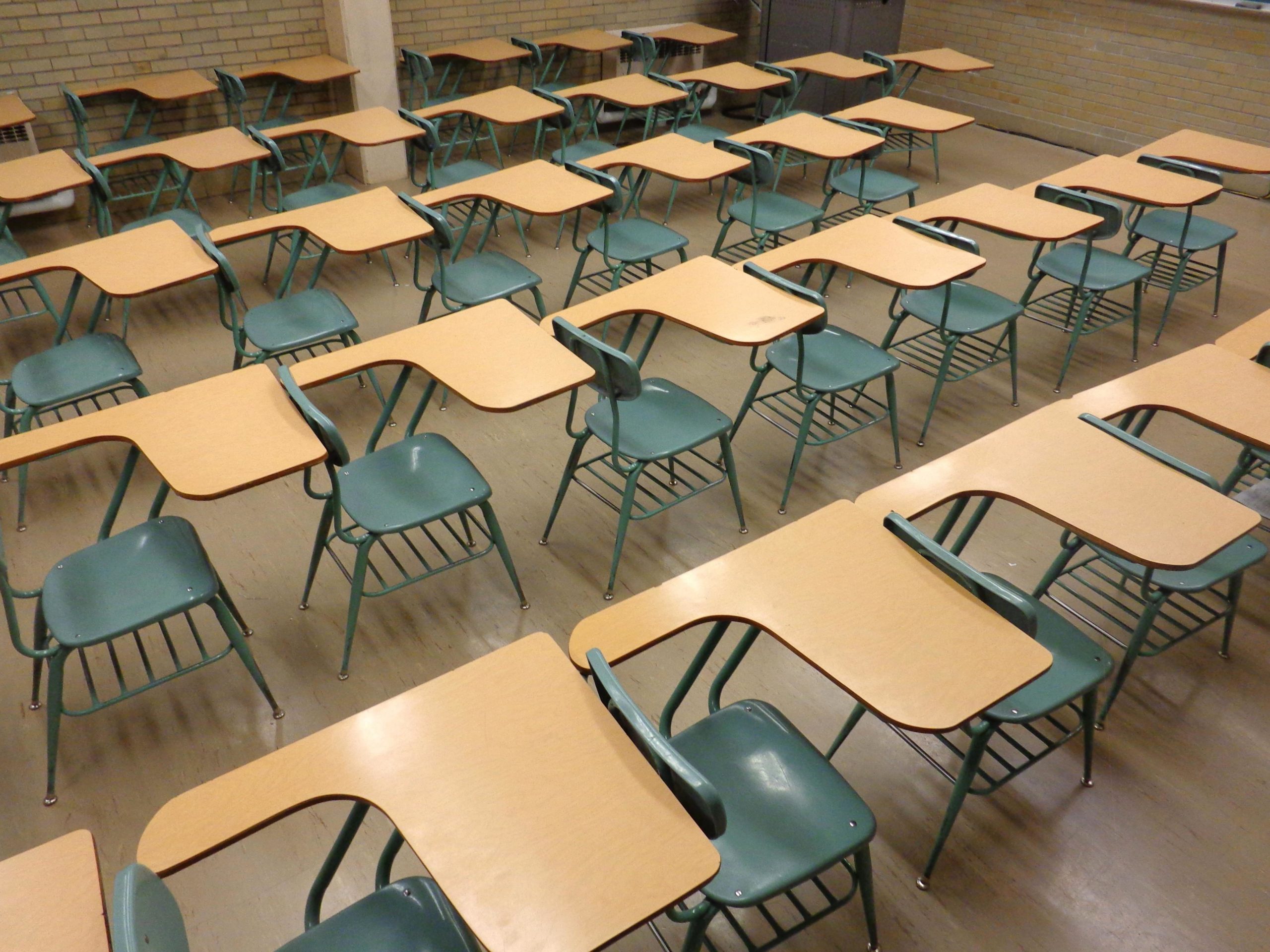Voters have decided on at least nine ballot measures related to religion in public schools during the past 100 years. The decade with the highest number was in the 1970s, when voters decided on four between 1970 and 1972. Topics included the Ten Commandments, the Bible, prayer and contemplation, religious clothing, excused absence for religious instruction, and students’ religious rights. The most common topic was school prayer, with five measures addressing prayer.
The following is a list of historical ballot measures addressing religion in public schools:
- California (1926): Voters rejected (43%-57%) a citizen-initiated constitutional amendment to allow public schools to purchase and use the Holy Bible, provided that no student is forced to read the Bible against their parents' or guardians' preferences.
- North Dakota (1948): Voters approved (53%-47%) a ballot initiative to prohibit public school teachers from wearing clothing or garb that indicates their affiliation with a religious order, sect, or denomination while performing their duties at school and enacting penalties for violating this rule.
- Maryland (1970): Voters approved (73%-27%) a constitutional amendment to provide that “nothing shall prohibit or require the making reference to belief in, reliance upon, or invoking the aid of God or a Supreme Being” in public institutions and places, including schools.
- Florida (1972): Voters approved (79%-21%) a non-binding question that asked, "Do you favor an amendment to the U.S. Constitution to allow prayer in the public schools?"
- Massachusetts (1972): Voters approved (82%-18%) a non-binding question that asked, "Shall the voluntary recitation of prayer be authorized in the public schools of the Commonwealth?"
- Wisconsin (1972): Voters approved (50.4%-49.6%) a constitutional amendment authorizing laws allowing public schools to release students during school hours to receive religious instruction elsewhere.
- West Virginia (1984): Voters approved (78.8%-22.2%) a constitutional amendment requiring public schools to set aside a period at the start of each school day for students who wish to engage in personal and private contemplation, meditation, or prayer.
- Missouri (2012): Voters approved (82.8%-17.2%) a constitutional amendment to provide that public school students can express their religious beliefs in written and oral assignments "free from discrimination based on the religious content of their work;" provide that public school students cannot be "compelled to perform or participate in academic assignments or educational presentations that violate his or her religious beliefs;" provide that public school students have a "right to free exercise of religious expression without interference;" and require public schools to display the text of the U.S. Constitution's Bill of Rights, among other provisions.
The most recent vote was in Alabama in 2018, when voters approved (71.7%-28.3%) a constitutional amendment, Amendment 1, allowing for the display of the Ten Commandments on public property, including public schools. The amendment allowed, but did not require, the Ten Commandments to be displayed on public properties. The amendment also said, "No public funds may be expended in defense of the constitutionality of this amendment."
Former State Sen. Gerald Dial (R-13) sponsored Alabama Amendment 1 in the legislature. He spoke about Louisiana's House Bill 71, which was designed to require the Ten Commandments to be displayed in classrooms beginning on Jan. 1, 2025. U.S. District Judge John W. deGravelles ruled Louisiana HB 71 unconstitutional on Nov. 12, 2024. Sen. Dial said, "We tried to go down that road to a degree. But then we were warned by all the legal scholars that it would be unconstitutional and it would just cost the state a lot of money to go all the way to the Supreme Court. And what I was doing was the most practical and easiest way and it would leave it up to the school boards and city managers and governmental officials to decide whether they wanted to put it up or not." In June 2024, Kayla Moore, president of the Foundation for Moral Law, said Alabama Amendment 1 had not been challenged in the courts.
The following map illustrates where voters have decided on ballot measures related to religion in public schools:

Additional reading:


